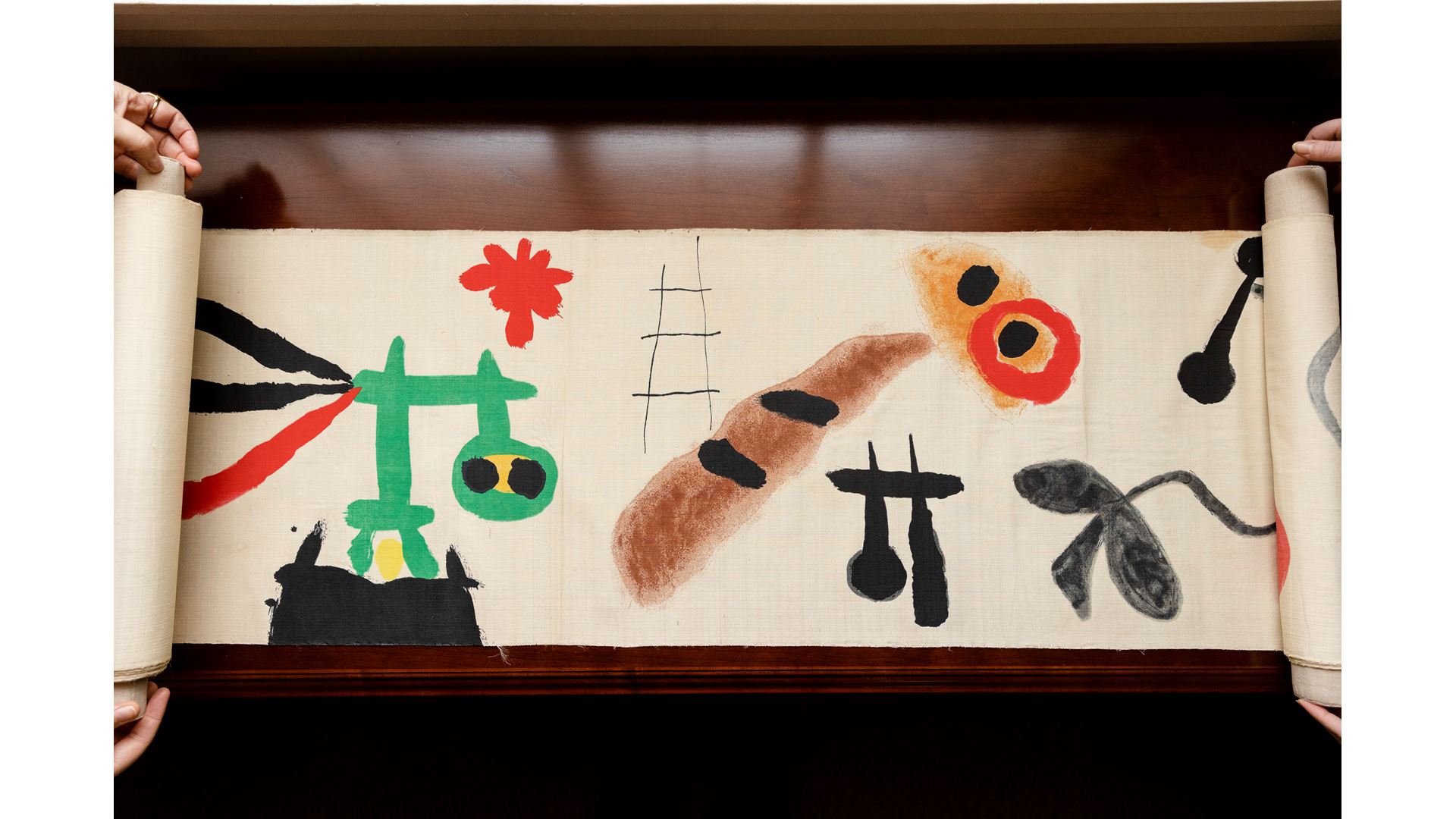- The illustrated scroll, created in 1956, is modeled after picture and calligraphic scrolls of ancient East Asian origin.
- Limited to 50 copies, Miró created the “Makemono” in the post-World War II period, partnering with French lithographer Aimé Maeght.
- “Makemono” is housed in the Rare Book and Special Collections Division, whose recently donated Aramont Library includes 14 other works by Miró.
Library of Congress Acquires Joan Miró’s “Makemono” Scroll
The 32-foot Scroll Joins Other Works of Art by the Spanish Surrealist at the Library
The Library of Congress has acquired Joan Miró’s “Makemono,” a 32-foot-long illustrated scroll the Catalan surrealist painter created in 1956, modeled after picture and calligraphic scrolls of ancient East Asian origin. The color lithograph on silk scroll joins other original prints and illustrated books by Miró, both in the Aramont Library and the Rosenwald Collection in the Library’s Rare Book and Special Collections Division.
Miró (1893-1983) is considered a pioneering surrealist artist who used color and form in a symbolic manner, creating a unique style of storytelling through elaborate designs and motifs that explore the human psyche. Limited to 50 copies, Miró created the “Makemono” in the post-World War II period, partnering with French lithographer Aimé Maeght to achieve a work of art that features vibrant colors and showcases great technical prowess.
“Makemono,” which was acquired through a purchase by the Library, is housed in the Rare Book and Special Collections Division (RBSCD), whose recently donated Aramont Library includes 14 other works by Miró. Among them are illustrated books that give viewers an understanding of his experimental printmaking techniques. A recently released From The Vaults video describes Miró’s “Constellations” series, a collection of 23 stencils based on the artist’s rare gouache paintings completed between the turbulent years of 1939 and 1941 that inspired many artists and poets in that period.
“When placed within the larger context of Miró’s illustrated works in the Rare Book and Special Collections Division, the ‘Makemono’ scroll becomes a clear demonstration of the artist’s exceptional gift for visual storytelling. We are very excited to work with our colleagues to share this unique and often overlooked aspect of Miró’s long and prolific career,” said Stephanie Stillo, curator of the Rosenwald Collection and Aramont Library.
Miró’s work, which influenced American abstract expressionist artists such as Alexander Calder, Jackson Pollock and Mark Rothko, can be found in the permanent collections of numerous art institutions, including the Art Institute of Chicago, the Museum of Modern Art and the Tate Modern.
“For me, this scroll is compelling because it brings Joan Miró’s signature appreciation of symbolic form and color alive through a material format that lends itself to cross-cultural language and communication. I can almost read Miró’s citations to Japanese cultural expression in this wonderful piece. We are excited to share it from the Library of Congress,” said Suzanne Schadl, chief of the Latin American, Caribbean and European Division.
Freed from the constraints of World War II, Miró became increasingly experimental in the 1950s. During this time, the artist turned his focus to printmaking exclusively for several years, seeking a new outlet for experimentation. In that context, the “Makemono” reflects the beginning of a new and exciting phase that lasted throughout the rest of his career.
Like traditional Asian scrolls that present a narrative journey for the viewer, Miró filled “Makemono” with his own biomorphic characters, an evolving visual language of figures that became the artist’s trademark throughout the 20th century. The “Makemono,” which features motifs such as birds, eyes and the moon, is stored in a hand-carved, painted and varnished wood box also composed by Miró.
“A thrilling quality of Miró is his strong relationship with poetry. For most of his career, the painter considered his pieces poems and argued on several occasions that, as art forms, poetry and painting were in extremely close vicinity. Few artists have been able to master such an exhilarating childlike and magical aesthetic language and achieve such a poetic visual universe,” said Catalina Gómez, reference librarian in the Latin American, Caribbean and European Division.
Miró, who abandoned his business school education to pursue painting, was fêted again and again throughout his career, including the grand prize for graphic work at the 1954 Venice Biennale, several career retrospectives in Paris and New York, and the Spanish Gold Medal for Fine Arts, among others. In acquiring Miró’s “Makemono,” the Library of Congress is helping to preserve his legacy for future generations.
The Library of Congress is the world’s largest library, offering access to the creative record of the United States — and extensive materials from around the world — both on-site and online. It is the main research arm of the U.S. Congress and the home of the U.S. Copyright Office. Explore collections, reference services and other programs and plan a visit at loc.gov; access the official site for U.S. federal legislative information at congress.gov; and register creative works of authorship at copyright.gov.
###
Media Contact: María Peña, mpena@loc.gov
Public Contact: Stephanie E. Stillo, ssti@loc.gov
PR 22-015
2022-02-25
ISSN 0731-3527

